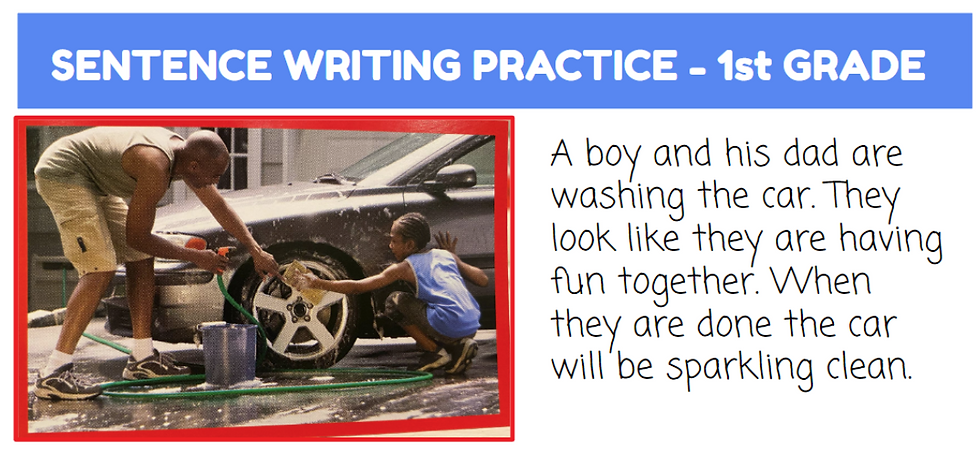Bubble Talk: Use Games with Narrative Writing
- Karen Kauo
- Sep 26, 2024
- 3 min read
Updated: 2 days ago
Looking for a fun, engaging way to have students practice their writing? Look no further! A favorite activity in my classroom is BUBBLE TALK!

Bubble Talk: Practice Narrative Writing
Bubble Talk is a game that comes with pictures and caption cards. The goal of the game is to match the pictures and caption cards together in fun, unusual ways.
You are certainly welcome to use it in this way, but for writing purposes, I ONLY use the picture cards!
The pictures from the game can be used in a variety of ways.
✏️Write sentences - simple, compound, complex
✏️Ask questions about the picture - who, what, when, where, why, how
✏️Describe the pictures in sentences using ADJECTIVES
✏️Practice the Show-not-Tell writing technique
✏️Write what happened just BEFORE the scene in the picture.
✏️Write what will happen just AFTER the scene in the picture
✏️Write a full narrative with the picture as inspiration
While BUBBLE TALK is my favorite, it is not the only game option. You can purchase a photo-based Apples to Apples game and PicWits also has great pictures!

To ensure that writing expectations are appropriate to the task, below is a reminder of the sentence level Language/Writing expectations for each grade along with narrative standards.
Narrative Writing By Grade Level
KINDERGARTEN
By the end of kindergarten students should be able to write a complete sentence that begins with a capital and ends with a period. Words should be phonetically spelled with sight words correctly. Differentiation: Students can write words for what they see in the picture.
Kindergartners can be tasked to ask a question about a picture, either in writing or verbally.

FIRST GRADE
Students in first grade should be able to write 3 or more complete sentences about a picture. Sentences should have proper capitals, end punctuation, and conventional spelling for words with common spelling patterns and for frequently occurring irregular words.
The Common Core Standards state that first graders should be able to produce and expand complete simple and compound declarative, interrogative, imperative, and exclamatory sentences in response to prompts.
If writing a narrative and using the picture for inspiration, a first grader can write two or more appropriately sequenced events, include some details regarding what happened, use temporal words to signal event order, and provide some sense of closure.

SECOND GRADE
Second graders should be able to produce, expand, and rearrange complete simple and compound sentences. Sentences should include proper capitals, end punctuation, and apostrophes in contractions with words spelled accurately for learned spelling patterns.
For the writing of a narrative, students can write a sequence of events that includes details to describe actions, thoughts, and feelings, use temporal words to signal event order, and provide a sense of closure.

THIRD GRADE
Third grade sentences can be simple, compound, or complex. Sentences contain proper punctuation and use of possessive nouns. Including dialogue with proper punctuation is also a third grade skill. Have students write what they think the person/animal in the photo might be saying. Spelling should be accurate for all learned spelling patterns and suffixes added to base words.
A third grade narrative would be written using effective technique, descriptive details, and clear event sequences. Students should write a sequence of events that include characters with dialogue and descriptions of their actions, thoughts, and feelings.
FOURTH GRADE
Fourth grade sentences can be simple, compound, or complex. Sentences contain all proper punctuation and the use of conjunctions with commas. All grade-level words are spelled correctly.
A fourth grade narrative will establish a plot that introduces a narrator and/or characters using dialogue and description to develop experiences and events or show the responses of characters to situations. In addition, writing should include sensory details to convey experiences and events precisely.
FIFTH GRADE
Fifth grade sentences should be accurately written and spelled using all of the expectations for grades K-4. Students should expand, combine, and reduce sentences for meaning and style.
A fifth grade narrative will establish a plot that introduces a narrator and/or characters using dialogue and description to develop experiences and events or show the responses of characters to situations. In addition, writing should include sensory details to convey experiences and events precisely.

Give BUBBLE TALK a try in your classroom!
If you do not want to purchase a game, check out my Narrative
Writing Resources using pictures on TPT:





Comments